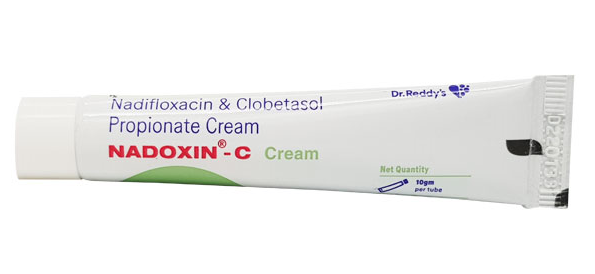Description
About Nadoxin C Cream
Nadoxin C Cream belongs to the class of dermatological medication, primarily used to treat bacterial skin infections. Bacterial infection occurs when harmful bacteria grow in the body and causes infection. It can infect any part of the body and multiply very quickly.
Nadoxin C Cream consists of two medicines, namely: Clobetasol (corticosteroid) and Nadifloxacin (antibacterial). Clobetasol is a highly potent corticosteroid with anti-inflammatory, antipruritic (relieves itching) and vasoconstrictive (narrows blood vessels) properties. It blocks the production of chemical mediators of inflammation (such as kinins, histamine, liposomal enzymes, prostaglandins) that make the skin red, swollen and itchy. On the other hand, Nadifloxacin is an antibacterial drug. It is bactericidal and works by killing bacteria that cause infections. It prevents bacterial growth by inhibiting the synthesis of essential proteins required by bacteria.
Use Nadoxin C Cream on the skin only as advised by the doctor. Nadoxin C Cream is generally safe to use. Some may experience side effects like burning, irritation, itching, redness and skin thinning at the application site. Most of these side effects of Nadoxin C Cream do not require medical attention and gradually resolve over time. If these side effects persist longer, please consult your doctor.
Avoid contact with your eyes, nose or mouth while using Nadoxin C Cream. Rinse it off with water thoroughly if you get the medication in these areas. Brief your medical history to doctor, if you are allergic to Nadoxin C Cream or any of its components. Therapy with topical corticosteroids like Clobetasol should be administered cautiously in patients with bacterial, fungal, viral and protozoa infections. Let your doctor know if you have any medical history of liver, kidney diseases, glaucoma, cataract, poor blood circulation, immune system problems, diabetes and adrenal gland diseases. Pregnant and breastfeeding women should use Nadoxin C Cream with proper consultation and caution.
Uses of Nadoxin C Cream
Medicinal Benefits
Nadoxin C Cream treats bacterial skin infections by killing and preventing the growth of bacteria. Nadoxin C Cream is a combination of two medicines, namely: Clobetasol and Nadifloxacin. Clobetasol is a corticosteroid and blocks the production of chemical mediators of inflammation, making the skin red, swollen and itchy. It effectively treats inflammation and itching caused by plaque psoriasis (skin cells build up to form itchy scales and dry patches) and other skin conditions. Nadifloxacin is an antibacterial drug that prevents the synthesis of essential proteins required by bacteria to carry out vital functions.
Directions for Use
Storage
Side Effects of Nadoxin C Cream
- Burning
- Irritation
- Itching
- Redness
- Thinning of skin
Drug Warnings
Brief your medical history to doctor, if you are allergic to Nadoxin C Cream or any of its components. Let your doctor know if you have any history of liver, kidney diseases, glaucoma, cataract, poor blood circulation, immune system problems, diabetes and adrenal gland diseases. Nadoxin C Cream is not recommended for diaper rash. Pregnant and breastfeeding women should use Nadoxin C Cream with proper consultation and caution. Do not use Nadoxin C Cream on the face and avoid contact with the eyes, nose and throat. Rinse it off with water thoroughly if you get the medication in these areas. Do not store Nadoxin C Cream above 25°C.
Drug Interactions
Drug-Drug Interaction: Nadoxin C Cream may interact with other corticosteroids (prednisone), and drugs that lower the immune system (cyclosporine).
Drug-Food Interaction: No interactions found.
Drug-Disease Interaction: Nadoxin C Cream is contraindicated in fungal, viral, protozoa infections, liver, kidney diseases, glaucoma, cataract, poor blood circulation, immune system problems, diabetes and adrenal gland diseases.
Drug-Drug Interactions Checker List
- PREDNISONE
- CYCLOSPORINE
Habit Forming
Diet & Lifestyle Advise
- Use mild soap while taking baths and prefer warm baths.
- Always wear loose-fitting clothes to avoid further sweat and spreading skin infection.
- Regularly change your socks and wash your feet. Avoid shoes that make your feet sweaty and hot.
- Do not walk barefoot at places like gym showers to prevent bacterial infections.
- Do not scratch the affected skin area as it can spread the infection to other body parts.
- Avoid sharing towels, combs, bedsheets, shoes or socks with others.
- Wash your bed sheets and towels regularly.
- Avoid or limit the intake of alcohol and caffeine.
- Manage stress, eat healthily, drink plenty of water, exercise regularly, and get plenty of sleep.
Disease/Condition Glossary
Bacterial skin infection: Bacterial skin infection occurs when bacteria penetrate through hair follicles or the skin breaks and infect the skin. Symptoms include redness, pain, and tenderness of the skin, minor bumps or boils, rashes, blisters, cracked/dry skin, swelling, stinging or burning sensation, pus formation, and itching. Bacterial skin infections are generally mild and can be treated using topical antibiotics. Sometimes, for a severe infection, an oral antibiotic may be required. Common bacterial infections include cellulitis (red and swollen skin), erysipelas (large patches on the skin), impetigo (red sores on the face), folliculitis (inflammation of hair follicles), and carbuncles (pus-filled bumps).






Reviews
There are no reviews yet.